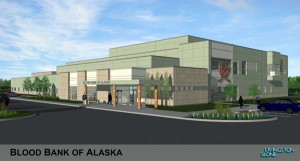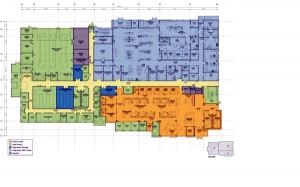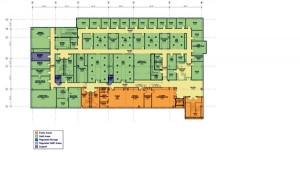
Soon workers will begin clearing trees across the street from Alaska Regional Hospital in the Airport Heights Neighborhood of Anchorage. They’re making space for a new building for the Blood Bank of Alaska. Officials say the facility will streamline their work and help ensure the Blood Bank is more prepared for a big emergency.
The Blood Bank’s main location is a lodge-themed building with wooden vaulted ceilings and a stone fireplace, just off Tudor near Lake Otis. Micah Smith works there. He draws blood from volunteers about 8 to 10 times a day.

“First thing we do is we find out if they’re eligible to donate,” Smith said. “They go through the questioning process.”
“After the questioning process we bring them to the chair, check the site to see if they have a good vein to go with. Then we’ll clean off their arm, then we’ll start the phlebotomy procedure.”
Today 22-year old Ashley Klinger from Eagle River is donating blood.
“All right, so go ahead and give me a good couple squeezes and hold. Alright, if you don’t like watching this part, now’s the time where you look away, alright. Okay, release your squeeze, gentle squeeze every 1 to 5 seconds,” Smith said.
Once the blood is drawn, it’s sent out for testing and once it’s approved, it’s kept in a giant refrigerator for shipment to wherever it’s needed. Unlike most states, Alaska only has one blood bank, which officials say makes getting its patchwork of existing offices under one roof and making it more efficient even more important. In all, the Blood Bank has five business sites around Anchorage. Four of those will be consolidated into the new building keeping only one off-site donation center in South Anchorage at the Dimond Mall. They’ll continue to have mobile drive collections around Anchorage though and around the state. The work will begin in August. Mark Fineman is with Cook Inlet Housing Authority. He’s the managing the construction of the two-story, 57,000 square foot facility for the Blood Bank of Alaska that will eventually sit on 4.28 acres at the corner of Airport Heights and Debarr Road. He says in the next couple of weeks workers will begin prepping the site for construction.

“We’re going to start cutting some trees down, clearing the site, grubbing it and bringing in some fill to start to prepare the building pad. But, basically we’re going to start some prep work,” Fineman said.
The actual construction of the building won’t begin for a year or two though, Fineman says. The Blood Bank of Alaska started in 1962. They moved into the building where they are now, near the Providence campus in 1981. But they’ve been outgrowing that facility for a while now, according to Director of Communications, Laura Carpenter.
“Some of our administrative offices happen off site. So my office is in a building off of Lake Otis. And our donor recruitment happens off of Old Seward and that’s also in an warehouse where we have our mobile collections,” Carpenter said.
Tom Livingston is an Architect with Livingston Slone Architects, the firm designing the new Blood Bank building. He designed the building the bank uses now, back in 1981. He says the requirements for the Blood Bank have changed a lot in the past 30 years, with the biggest change being testing.

“When they first opened this in the early 60s, the blood bank, they were up to three tests. When we opened this building in the 80s we were up to 65. And now, I believe we’re up to 16 tests per unit of blood, for good reason,” Livingston said.
Livingston says his design accommodates the expanded testing. Bob Scanlon is the CEO of Blood Bank of Alaska. He says the labs in the new facility are important for the Blood Bank to become more self-sufficient.
“We’re going to have a reference lab. It’s a place where advanced blood work ups can be done for compatibility and such. But we’re also gonna have a testing lab. Right now currently for our testing, for HIVtesting and such, we’re having to send those samples down to Seattle. We would like to be able to do that function right here in the state of Alaska,” Scanlon said.

Being able to do their own tests, Scanlon says will save time and money, and could prove critical in the event of a large-scale emergency. The state of Alaska is providing $19 million in funding for the project. The blood Bank hopes to get the rest of the funds through corporate, foundation and individual donations. Construction of the building won’t begin in earnest until the summer of 2013 or 2014. The new Blood Bank building is set to be completed sometime in 2015.
Daysha Eaton is a contributor with the Alaska Public Radio Network.
Daysha Eaton holds a B.A. from Evergreen State College, and a M.A. from the University of Southern California. Daysha got her start in radio at Seattle public radio stations, KPLU and KUOW. Before coming to KBBI, she was the News Director at KYUK in Bethel. She has also worked as the Southcentral Reporter for KSKA in Anchorage.
Daysha's work has appeared on NPR's "Morning Edition" and "All Things Considered", PRI's "The World" and "National Native News". She's happy to take assignments, and to get news tips, which are best sent via email.
Daysha became a journalist because she believes in the power of storytelling. Stories connect us and they help us make sense of our world. They shed light on injustice and they comfort us in troubled times. She got into public broadcasting because it seems to fulfill the intention of the 4th Estate and to most effectively apply the freedom of the press granted to us through the Constitution. She feels that public radio has a special way of moving people emotionally through sound, taking them to remote places, introducing them to people they would not otherwise meet and compelling them to think about issues they might ordinarily overlook.




